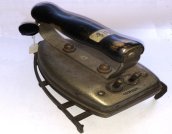

Castle Cary Museum has a wonderful collection of smoothing irons. Here they are laid out as a fleet of Ironclads pressed into service as ships of the line-n each with a determination to flatten all that is put before it.
The most unstable of all our irons has a rounded-bottom profile which, when brought into contact with its intended workpiece, gives new meaning to the expression "hot under the collar".
It is a collar starching iron.


This iron, identified as a Geese-Goose, is remarkably similar to a Geese-Gander. The former is favoured by tailors and drapers, the latter has wandered off.
This brick-based iron - although clogged up in the rear where one is expected to insert a red hot brick - is a fine specimen though the loss of a handle reduces its efficiency somewhat.
It does however possess a rugged beauty which no doubt saved it from being flattened (presumeable by another iron with a handle).



This iron is made thermally active by the insertion of hot charcoal into its innards. It has a tendancy to emit flying sparks from the breather holes along its sides, therefore the user should bear in mind that a bare disposition whilst ironing will lead to a little discomfort.
Some irons can become thermally unstable when smoothing movements slow down or cease altogether. In such cases, the deployment of a firewall to protect the underlying softwear is not practicable.


A methylated-spirits-fired iron augments the stock of larger irons and has the added advantage that it can be carried in the pocket.
The usual precautions apply.
In an iron-centric environment such as Castle Cary Museum's iron section, there may be detractors who say that a brass device should should be in the brass section. That would be appropriate only if a tune could be played on it. The item lies mute with the irons.


The museum has one gas-heated iron.
It is quiet at the moment.
Eco-friendly electrically-heated irons are well represented within the museum.
The first is burnt out, the second is exhausted.
